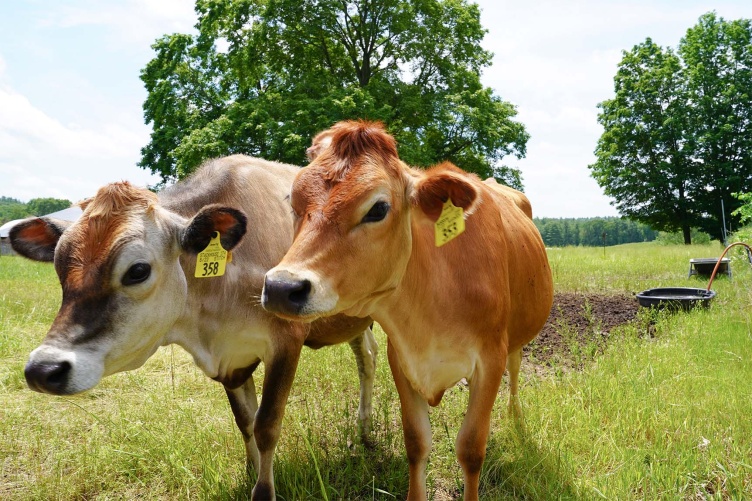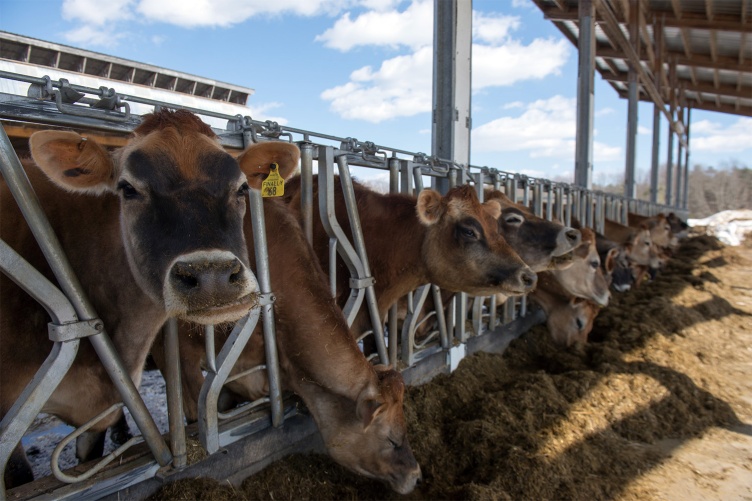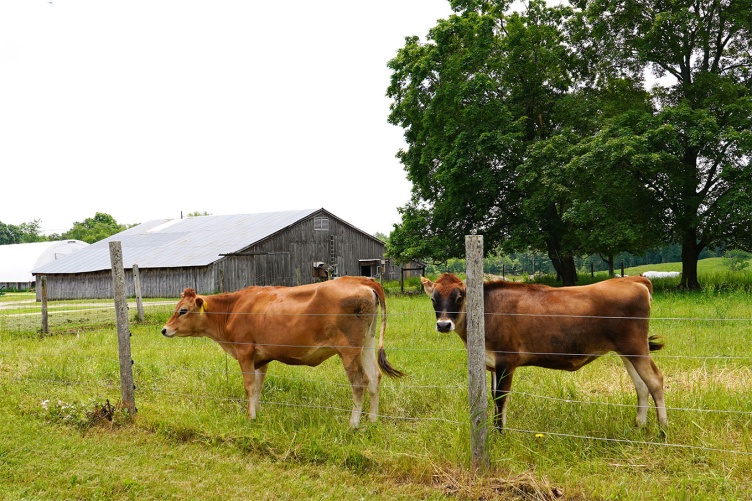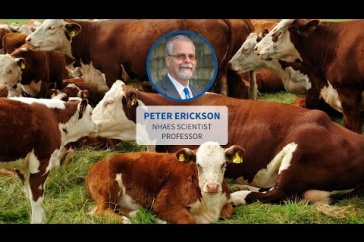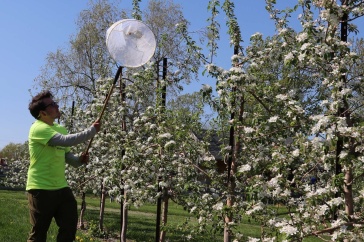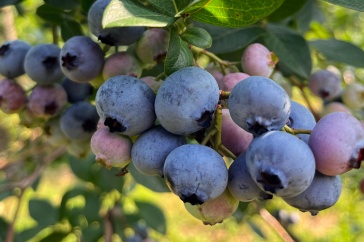Key Research Finding
In a survey of Maine organic dairy farmers, nearly 93 percent of respondents cited rising industry costs, supply issues and deteriorating infrastructure as more pressing concerns over climate change and regulation. However, nearly half of respondents also reported a willingness to pay, on average, an additional $0.64 per cow per day for methane-reducing algal-based feed.
Key Terms
Chondrus crispus: Known by the common names Irish moss or carrageen moss, C. crispus is a species of red algae or seaweed that grows along the Atlantic Ocean’s rocky coastlines, including the Gulf of Maine and the coastlines of Eastern Canada and the United Kingdom. Preferring cooler temperatures ranging from 60-70 degrees Fahrenheit, C. crispus is a perennial seaweed commonly found in intertidal and tide pools. It’s used in a variety of human products, including as a thickener in foods like ice cream and soups and as a natural source of minerals like potassium, calcium and iodine.
The Organic Dairy Industry in New England: 2019-2022
According to the USDA National Agricultural Statistics Service Information (NASS) 2021 Organic Survey, New England had 236 organic-certified dairies, including 15 in New Hampshire, 60 in Maine and 156 in Vermont. Altogether, these dairies produced sales of more than $4.70 million.
New England’s dairy sector continues to evolve in response to significant market challenges associated with higher input and land costs, decreased availability of a skilled labor force and decreasing demand for milk. The dairy farmers who remain—a small fraction of the more than 10,000 who were in the region in the 1950s—must balance production costs and new and innovative marketing opportunities, such as targeting certified organic milk markets, which can set their dairy products apart from conventionally produced milk and garner higher prices. There is also evidence that organic dairy farming can provide environmental benefits—such as reducing methane release—which could further differentiate their products as well as help qualify farms for new government initiatives to reduce methane emissions through innovative management practices, such as adding seaweed to animal feed. The catch? The feed additives can be expensive, which can throw off the careful economic balancing act.
Recent research from New Hampshire Agricultural Experiment Station scientist Andre Brito, an Associate Professor of Dairy Cattle Nutrition and Management at UNH, and Ph.D. candidate Diana Reyes set out to assess how much New England organic dairy farmers would be willing to increase their costs to adopt these methane-reducing practices. Their survey study of Maine organic dairy farmers was published in Frontiers in Veterinary Science and included a cross-disciplinary team of scientists from research facilities and teams in New Hampshire and Maine.
“Dairy farmers aim to run their farms as lucrative enterprises,” explained Brito, “so the additional costs would require serious considerations, as well as more data and an effective implementation of carbon markets in the future.”
The research team surveyed 35 organic dairy farmers, all of whom were familiar with seaweed-based feeds and a third of whom were already using such feeds on their farms. Nearly half of respondents reported a willingness to pay, on average, an additional $0.64 per cow per day for methane-reducing seaweed-based feed.
The survey also revealed that 93 percent of the farmers were more concerned about issues like labor shortages, infrastructure problems, rising costs and unstable supply chains, rather than climate change and regulation. This means that farmers would only consider using seaweed in their cows' diets if it is cost-effective and has additional benefits, while also aligning with existing feeding practices and receiving support from government policies and subsidies.
“Dairy farmers aim to run their farms as lucrative enterprises, so the additional costs would require serious considerations, as well as more data and an effective implementation of carbon markets in the future.” ~ Andre Brito, Associate Professor of Dairy Cattle Nutrition and Management
As part of the study, the researchers conducted a feeding trial at Wolfe's Neck Center for Agriculture & the Environment (Freeport, ME), where they fed 22 cows a diet of containing six percent red seaweed (C. crispus)—harvested from the Maine coastline—from February through May of 2021. The results of the trial showed that adding this seaweed to the cows' diet reduced methane production by 13.9 percent without affecting milk production and quality.
“Our goal was to source locally available red seaweed with methane mitigation potential to reduce transportation and feed costs,” explained Brito. “And based on our preliminary research, C. crispus emerged as a viable candidate to be tested in feeding trials.”
He added, “Testing C. crispus on a working organic dairy farm showed this seaweed with medium methane decrease potential, indicating that further research is needed to identify the bioactive compounds present in C. crispus responsible for the reduction in methane.”
According to Nichole Price, a senior research scientist with the Bigelow Laboratory for Ocean Sciences and the director of the Bigelow Center for Seafood Solutions, Maine serves as the ideal location to examine how the seaweed and organic dairy farming can work in unison.
“Maine is the birthplace of temperate seaweed farming in the U.S., and it also supports organic certification of seaweeds,” said Price. “Plus, the close proximity of the nascent seaweed industry to organic dairy farms makes Maine the perfect testbed for this exciting line of inquiry.”
This material is based on work supported by the NH Agricultural Experiment Station through joint funding from the USDA National Institute of Food and Agriculture (under Hatch award numbers 1017808) and the state of New Hampshire. Additional support comes from the Shelby Cullom Davis Charitable Fund Inc. and the Sustainable Agriculture Systems grant no. 2021-69012-35919 from the USDA National Institute of Food and Agriculture, as well as the USDA-National Institute of Food and Agriculture Hatch Multistate NC-2042 (Project Number NH00670-R; Kansas City, MO).
This work is co-authored by Diana Reyes (UNH), Jennifer Meredith (Colby College), Leah Puro (Wolfe’s Neck Center for the Agriculture and the Environment), Katherine Berry (Wolfe’s Neck Center for the Agriculture and the Environment), Richard Kersbergen (University of Maine Cooperative Extension), Kathy Soder (USDA), Charlotte Quigley (Bigelow Laboratory for Ocean Sciences), Michael Donihue (Colby College), Dorn Cox (Wolfe’s Neck Center for the Agriculture and the Environment), Nichole Price (Bigelow Laboratory for Ocean Sciences) and Andre Brito (UNH).
-
Written By:
Nicholas Gosling '06 | COLSA/NH Agricultural Experiment Station | nicholas.gosling@unh.edu



















































